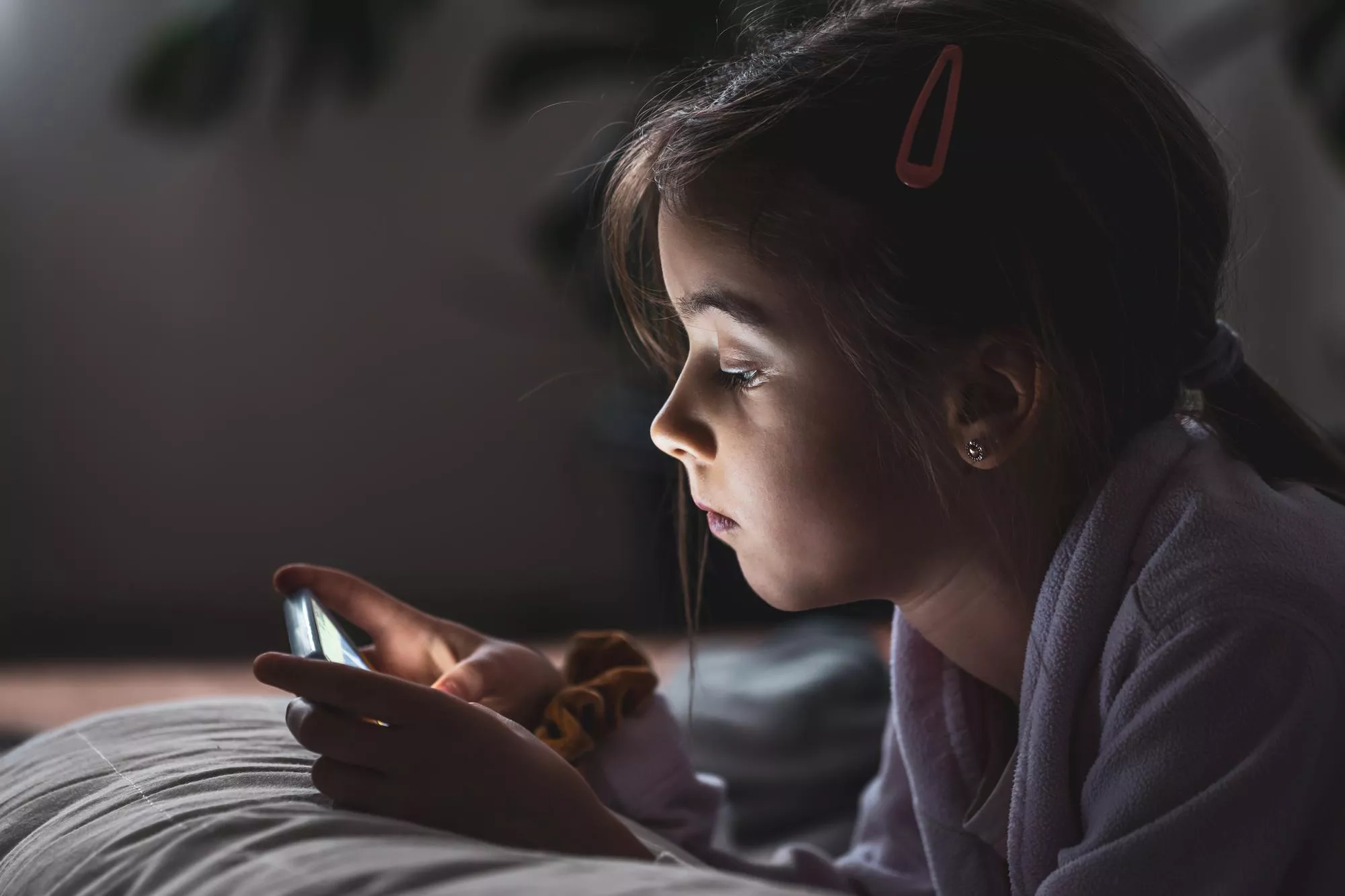In today’s digital era, screens are an integral part of our life. Post COVID, from learning to entertainment and social interactions, all of us are spending more time in front of screens than ever before. While technologies are beneficial, excessive screen time can negatively impact a child’s development, physical and mental health, and over all well-being.
As a pediatrician, I frequently encounter concerned parents asking: How much screen time is too much? and how can we create a healthy balance? Let’s explore the effects of screen time, recommended guidelines, and practical strategies to ensure responsible usage.
Effects of Excessive Screen Time:
Too much screen exposure can affect children in multiple ways:
1.Sleep Disruptions:
Screens emit blue light which suppresses melatonin (the hormone responsible for sleep). This can result in difficulty falling asleep, poor quality of sleep and disturbed sleep pattern.
2.Delayed Social, Language and Emotional Development:
Children who spend excessive time on screens may have fewer face-to-face interactions, leading to delays in language development, reduced empathy, and difficulty understanding social cues.
3.Obesity and Physical Health Concerns:
Sedentary screen time replaces active play, leading to decreased physical activity, a higher risk of obesity, and related health problems such as diabetes and poor posture. Food advertisement is an important link connecting media time with unhealthy food consumption and subsequent obesity.
4.Attention and Learning Challenges:
The fast-paced content on digital platforms can shorten a child’s attention span, making it harder for them to focus in school and develop patience for problem-solving.
5.Emotional and Behavioral Issues:
Increased screen time has been linked to irritability, anxiety, depression, and difficulty managing emotions. Exposure to violent or inappropriate content can also influence aggressive or impulsive behaviors.
6.Eye Strain and Headaches:
Extended screen use, especially close-up viewing, can lead to digital eye strain, headaches, dry eyes, and even nearsightedness (myopia).
Recommended Screen Time Guidelines
The IAP (Indian Academy of Pediatrics) provides the following recommendations for daily screen time:
- Infants and children 0-23 months age: should not be exposed to any type of screen.
- Children 24-59 months age: Limit screen time to a maximum of 1 hour (per day with each session not more than 20-30 min); the lesser, the better
- Children 5-10 years age: Limit screen time to less than 2 hours per day; the lesser, the better. This includes recreational screen time, and time spent on screen at home to complete educational and extra-curricular assignments.
- Adolescents (10-18 years age): Balance screen time with other activities that are required for overall development. Set consistent limits, ensuring screen use does not interfere with sleep, physical activity, and real-life interactions.
Practical Tips for Managing Screen Time:
Striking the right balance between screen time and other activities can be challenging, especially with screens being so accessible in our daily lives. Here are some practical, real-life strategies that parents and caregivers can use to help children develop healthy digital habits while ensuring their overall well-being.
1.Create Screen-Free Zones at Home
Designate specific areas in the house where screens are not allowed. This helps in reducing passive screen exposure and encourages family bonding.
Examples:
- No screens at the dining table – This ensures family meals are focused on conversations rather than distractions.
- Keep bedrooms screen-free – This helps improve sleep hygiene and prevents late-night screen usage.
- A "charging station" in the living room – Require kids to leave their devices there overnight.
Alternative Activities:
- Engage in family discussions, storytelling, or board games during meals.
- Introduce bedtime routines like reading books or gentle music instead of watching videos.
2. Set a Daily Screen Time Schedule
A structured screen time schedule helps children understand when and for how long they can use devices.
Examples:
- Weekday Limit: No screens before school, limited to 1 hour after homework.
- Weekend Limit: Screen time allowed only after outdoor play or creative activities.
- Reward-Based Usage: Allow extra screen time as a reward for good behavior (e.g., finishing chores, reading a book).
Alternative Activities:
- Encourage children to use an analog wall calendar or a timer to track their screen usage.
- Use visual charts with stickers to motivate younger children to stick to schedules.
3. Encourage Active Breaks (The 20-20-20 Rule)
Spending long hours on screens can lead to eye strain, poor posture, and reduced physical activity. Introducing short breaks ensures better health and engagement in non-digital activities.
Examples:
- Follow the 20-20-20 Rule: Every 20 minutes, look 20 feet away for 20 seconds to rest the eyes.
- Set a screen-time timer to remind kids to take movement breaks.
- After every 30 minutes of screen time, do 10 jumping jacks or a quick walk.
Alternative Activities:
- Use interactive fitness apps (like Just Dance or Nintendo Ring Fit) to turn screen time into movement-based play.
- Challenge kids to a family step-count competition using a pedometer or smartwatch.
4. Prioritize Outdoor Play and Physical Activities
Outdoor play is crucial for a child’s physical and mental development. It reduces stress, strengthens muscles, and encourages creativity.
Examples:
- Enroll children in sports clubs like soccer, swimming, or gymnastics.
- Plan weekend hikes, picnics, or biking trips instead of watching TV.
- Organize neighborhood playdates to encourage socialization.
Alternative Activities:
- Invest in outdoor toys like bicycles, roller skates, or a basketball hoop.
- Plan family activities like gardening or nature scavenger hunts.
5. Co-View and Discuss Digital Content
Instead of banning screens altogether, engage with your child while they watch or play. This helps them understand educational content, internet safety, and digital responsibility.
Examples:
- Watch documentaries or science shows together and discuss them.
- Use apps like Duolingo (for language learning) or Tynker (for coding games) instead of passive video watching.
- Encourage them to explain what they learned after watching a video.
Alternative Activities:
- Assign fun research projects – Ask kids to find interesting facts online and share them at dinner.
- Teach safe online behavior – Discuss topics like cyberbullying, privacy, and fact-checking.
6. Monitor and Use Parental Controls
While technology is a great learning tool, not all content is child-friendly. Using parental controls ensures kids access only appropriate and educational content.
Examples:
- Enable YouTube Kids instead of unrestricted YouTube access.
- Set up family-sharing settings on iPads or phones to monitor app usage.
- Use tools like Google SafeSearch and Netflix Kids Profile for safer browsing.
Alternative Activities:
- Encourage kids to create instead of consume – Let them try digital art, storytelling, or making their own educational videos.
- Introduce screen-time contracts – A fun way to let kids agree to responsible screen use with signed agreements.
7. No Screens Before Bedtime (at Least 1 Hour Before Sleep)
Screen exposure before bedtime disrupts melatonin production, making it harder for kids to sleep.
Examples:
- Set an alarm for "screen-off time" an hour before bedtime.
- Replace nighttime TV shows with audiobooks or guided bedtime stories.
- Use warm lighting instead of bright screens for winding down.
Alternative Activities:
- Let kids choose a book to read before bed.
- Introduce relaxing bedtime yoga or breathing exercises.
8. Be a Role Model:
Children imitate their parents. If they see you glued to a screen, they are likely to do the same.
Examples:
- Limit your own screen time during family time.
- Avoid checking your phone during meals or conversations.
- Show excitement for non-screen activities like reading, cooking, or exercising.
Alternative Activities:
- Make "tech-free evenings" where the whole family disconnects from screens.
- Engage in a family hobby like painting, board games, or storytelling.
9. Use Screens for Learning, Not Just Entertainment:
Encourage children to use screens as a tool for learning and creativity, rather than passive entertainment.
Examples:
- Introduce coding platforms like Scratch or Minecraft Education.
- Encourage digital storytelling using apps like Book Creator.
- Use educational apps like Khan Academy, ABC Mouse, or Prodigy Math.
Alternative Activities:
- Ask kids to create their own educational videos explaining a concept.
- Encourage them to write stories or journals on a tablet instead of watching cartoons.
10. Encourage Social Interaction:
Screens should not replace face-to-face human interactions, which are essential for a child’s social skills and emotional development.
Examples:
- Organize family game nights with board games instead of watching TV.
- Encourage weekly in-person playdates with friends.
- Get kids involved in volunteer work or community events.
Alternative Activities:
- Teach kids letter writing or journaling as a way to communicate.
- Introduce team-based activities like drama clubs, debate teams, or scouting.
Conclusion:
Technology is an integral part of modern life, and rather than completely banning screen time, moderation and mindful use are the keys to raising a healthy, well-rounded child.
By setting clear boundaries, offering alternative activities, and actively engaging in children’s digital experiences, parents can help shape responsible digital habits while promoting a balanced lifestyle.
Let’s guide our children to use technology as a tool for learning and creativity, rather than letting it replace real-world interactions and experiences.








